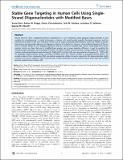| dc.contributor.author | Rios, Xavier | |
| dc.contributor.author | Briggs, Adrian | |
| dc.contributor.author | Christodoulou, Danos C. | |
| dc.contributor.author | Gorham, Josh McClean | |
| dc.contributor.author | Seidman, Jonathan G. | |
| dc.contributor.author | Church, George McDonald | |
| dc.date.accessioned | 2013-03-08T18:17:51Z | |
| dc.date.issued | 2012 | |
| dc.identifier.citation | Rios, Xavier, Adrian W. Briggs, Danos Christodoulou, Josh M. Gorham, Jonathan G. Seidman, and George M. Church. 2012. Stable gene targeting in human cells using single-strand oligonucleotides with modified bases. PLoS ONE 7(5): e36697. | en_US |
| dc.identifier.issn | 1932-6203 | en_US |
| dc.identifier.uri | http://nrs.harvard.edu/urn-3:HUL.InstRepos:10381379 | |
| dc.description.abstract | Recent advances allow multiplexed genome engineering in E. coli, employing easily designed oligonucleotides to edit multiple loci simultaneously. A similar technology in human cells would greatly expedite functional genomics, both by enhancing our ability to test how individual variants such as single nucleotide polymorphisms (SNPs) are related to specific phenotypes, and potentially allowing simultaneous mutation of multiple loci. However, oligo-mediated targeting of human cells is currently limited by low targeting efficiencies and low survival of modified cells. Using a HeLa-based EGFP-rescue reporter system we show that use of modified base analogs can increase targeting efficiency, in part by avoiding the mismatch repair machinery. We investigate the effects of oligonucleotide toxicity and find a strong correlation between the number of phosphorothioate bonds and toxicity. Stably EGFP-corrected cells were generated at a frequency of \(\sim\)0.05% with an optimized oligonucleotide design combining modified bases and reduced number of phosphorothioate bonds. We provide evidence from comparative RNA-seq analysis suggesting cellular immunity induced by the oligonucleotides might contribute to the low viability of oligo-corrected cells. Further optimization of this method should allow rapid and scalable genome engineering in human cells. | en_US |
| dc.language.iso | en_US | en_US |
| dc.publisher | Public Library of Science | en_US |
| dc.relation.isversionof | doi:10.1371/journal.pone.0036697 | en_US |
| dc.relation.hasversion | http://www.ncbi.nlm.nih.gov/pmc/articles/PMC3351460/pdf/ | en_US |
| dash.license | LAA | |
| dc.subject | Biology | en_US |
| dc.subject | Biochemistry | en_US |
| dc.subject | Nucleic Acids | en_US |
| dc.subject | DNA | en_US |
| dc.subject | DNA recombination | en_US |
| dc.subject | Synthetic Nucleic Acids | en_US |
| dc.subject | Biophysics | en_US |
| dc.subject | Biotechnology | en_US |
| dc.subject | Genetic Engineering | en_US |
| dc.subject | Genomics | en_US |
| dc.subject | Functional Genomics | en_US |
| dc.subject | Genome Expression Analysis | en_US |
| dc.subject | Molecular Cell Biology | en_US |
| dc.subject | Synthetic Biology | en_US |
| dc.title | Stable Gene Targeting in Human Cells Using Single-Strand Oligonucleotides with Modified Bases | en_US |
| dc.type | Journal Article | en_US |
| dc.description.version | Version of Record | en_US |
| dc.relation.journal | PLoS ONE | en_US |
| dash.depositing.author | Seidman, Jonathan G. | |
| dc.date.available | 2013-03-08T18:17:51Z | |
| dc.identifier.doi | 10.1371/journal.pone.0036697 | * |
| dash.contributor.affiliated | Briggs, Adrian | |
| dash.contributor.affiliated | Christodoulou, Danos | |
| dash.contributor.affiliated | Rios, Xavier | |
| dash.contributor.affiliated | Gorham, Joshua | |
| dash.contributor.affiliated | Seidman, Jonathan | |
| dash.contributor.affiliated | Church, George | |


